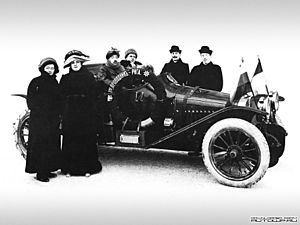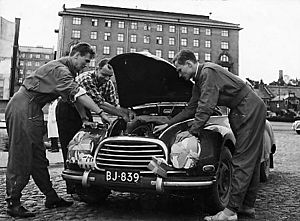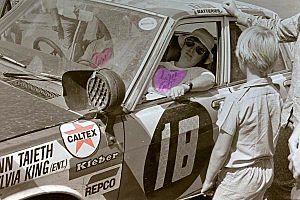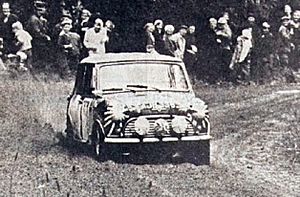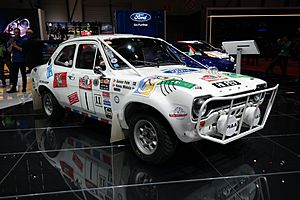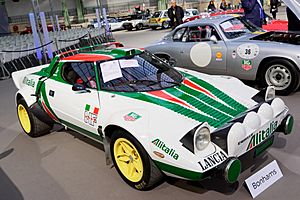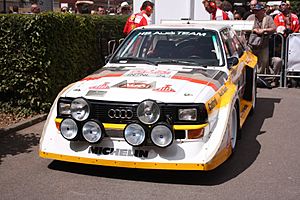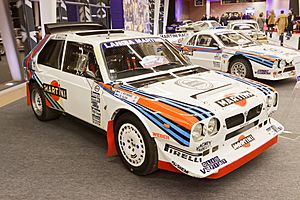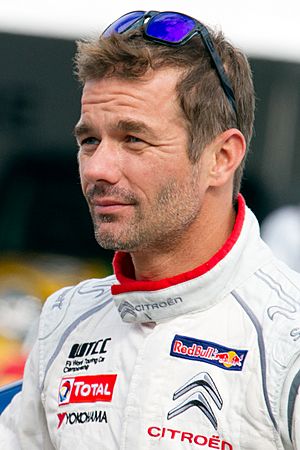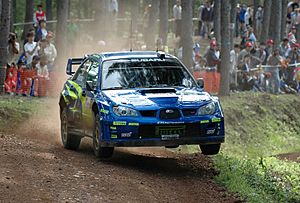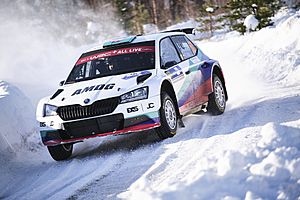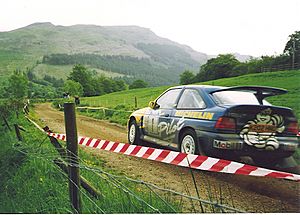Rallying facts for kids
Rallying is an exciting type of car racing that happens on public or private roads. Unlike track racing, rally cars drive from one point to another, often on challenging routes. Drivers and their co-drivers leave at different times and try to be the fastest on special timed sections called "special stages." Sometimes, they win by driving at a perfect, set speed.
Contents
History of Rallying
Early Days of Car Races
The word "rally" for car racing probably started with the first Monte Carlo Rally in January 1911. But car races began much earlier! In 1894, a newspaper in Paris, France, held the "Paris–Rouen Horseless Carriage Competition." People were very interested, and many car makers joined. Cars drove between cities, starting at different times, and had checkpoints along the way. They used road books to find their way on long, often gravel, roads.
One of the first big races was the Paris–Bordeaux–Paris race in 1895. Émile Levassor drove 1,178 kilometers (732 miles) in just under 49 hours! Speeds got very high, and races became dangerous on public roads. In 1903, the French government stopped the Paris–Madrid race because of many crashes and deaths. After this, racing in Europe mostly moved to closed tracks.
However, some long-distance road events continued. Italy had races like the Targa Florio from 1906. In Britain, the "Thousand Mile Trial" in 1900 promoted cars by linking major cities. Germany had the "Prinz Heinrich Trial" from 1908, which attracted top drivers.
Then, in 1911, the first Monte Carlo Rally was held. It was organized to attract rich people to Monaco in winter. Getting there was a challenge itself!
Rallying Between World Wars
World War I paused rallying. The Monte Carlo Rally started again in 1924 and became a very important European rally in the 1930s. Many "Alpine" rallies also began in countries like Austria, Italy, and France, challenging drivers on mountain roads.
Other important rallies started, like Britain's RAC Rally (1932) and Belgium's "Liège-Rome-Liège" (1931). The RAC Rally was a gentle tour with skill tests, while the Liège was a tough race on mountain roads. In Ireland, the "Ulster Motor Rally" became the Circuit of Ireland Rally. Italy had the famous Mille Miglia (Thousand Mile) race from 1927, a 1,000-mile loop from Brescia to Rome and back.
After World War II
After World War II, the 1950s were a "Golden Age" for long-distance road rallies. New classic events appeared, such as the Lisbon Rally (Portugal), the Tulip Rally (Netherlands), and the Rally of the 1000 Lakes (Finland, now Rally Finland).
In 1953, the FIA (the international motorsports group) created the European Rally Championship. Later, in 1973, they started the World Rally Championship for car makers, and in 1979, for drivers.
Some rallies, like the French Alpine and the Liège, were very tough. Drivers had to go "flat out" (as fast as possible) from start to finish. The Monte Carlo Rally was famous and attracted many people, especially when it snowed. The Tour de Corse in Corsica, France, started in 1956. It was a 24-hour race on narrow, twisty mountain roads. A woman, Belgium's Pat Moss, won a major rally for the first time in 1956 in a Renault Dauphine.
The idea of "special stages" began in Sweden and Finland in the 1950s. These were shorter sections of road, usually on private or minor roads away from traffic, where cars were timed separately. This solved the problem of racing on open public roads. The idea spread, and the RAC Rally in Britain, for example, started using forest roads for special stages in 1961, becoming a very popular event. It is now called Rally GB.
Rallies Around the World
In other parts of the world, especially where there were many remote roads, other rallies started. In South America, there were long city-to-city races, like the "Gran Premio del Norte" in 1940. The dangerous Carrera Panamericana in Mexico ran from 1950 to 1954. These races became too expensive and difficult to organize.
In Africa, the "Méditerranée-le Cap" rally started in 1950, going 10,000 miles from the Mediterranean to South Africa. The demanding Coronation Safari in East Africa became the famous Safari Rally, a World Championship event. Australia also had its "Redex Round Australia Trial" from 1953.
Intercontinental Challenges
People wanted even longer and tougher rallies. In 1968, the London–Sydney Marathon took cars across Europe, the Middle East, and Asia, then by ship to Australia for the final drive to Sydney. This led to the "World Cup Rallies." The first was the 1970 London to Mexico World Cup Rally, which crossed Europe and South America.
These huge intercontinental rallies became less common after the 1970s due to costs and other issues. However, in 1979, a Frenchman named Thierry Sabine started the first "rallye-raid" from Paris to Dakar, Senegal. This event, now called the Dakar Rally, became a huge success and led to a new type of rallying called "Rally Raid." Since 2008, the Dakar Rally has been held in South America.
Rallying Today
Special stages changed rallying into its modern form. It meant drivers had to be very fast. Over time, rallies have become shorter, and night driving is less common. While some older international events are gone, new ones have appeared in many countries, making rallying a worldwide sport.
Long-distance events still exist, like the Baja 1000 in Mexico, started in 1967. This tough 1,000-mile race for cars and motorcycles goes through the Baja California peninsula, often over desert terrain.
How Rally Cars Changed
Car manufacturers have been involved in rallies from the very beginning. Before World War II, most rally cars were standard production cars with only small changes. This kept costs down and allowed many people to join the sport.
As rallying became more popular, car companies started making special models for it. The Mini Cooper (1962) and Mini Cooper S (1963) were very successful. Ford made the Escort Twin Cam in 1968, which became a top rally car. Lancia even designed a car just for rallies, the Lancia Stratos, which was very dominant in its time.
In 1980, Audi introduced the Audi Quattro. It was a large car with a powerful turbocharged engine and, most importantly, four-wheel drive. At first, rules didn't allow four-wheel drive, but the FIA changed them because the Quattro was a real production car. The Quattro quickly became the car to beat on snow, ice, and gravel.
This led to the "Group B" era. Rules changed again, allowing cars to be much more different from standard production models. This created incredibly powerful "rallying supercars" like the Peugeot 205 T16 and Lancia Delta S4, with up to 600 horsepower! However, this era was short-lived. After several serious accidents and deaths in 1986, the rules were changed again. From 1987, rallying used "Group A" cars, which were much closer to production models. The Lancia Delta Integrale was very successful during this time, winning six world rally championships in a row.
Rally Drivers
In the 1950s, most rally drivers were amateurs. But in 1960, Erik Carlsson from Sweden became one of the first full-time professional rally drivers for Saab.
In the 1960s, a team manager named Stuart Turner hired talented young drivers from Finland. These "Flying Finns" were skilled at driving on gravel and snow. This helped create the modern professional rally driver. As special stage rallying grew, drivers from many other countries also became top competitors.
Types of Rallies
There are two main types of rallies:
- Stage Rallies: These are the professional part of the sport. Cars race for pure speed on roads closed to other traffic. These roads can be flat asphalt, mountain passes, rough forest tracks, ice, snow, or desert sand. Each surface tests the car and crew.
- Road Rallies: These are the original type, held on public roads with normal traffic. The goal is not speed, but accurate timekeeping and navigation. These are mostly amateur events now. They can test your ability to stay on time, navigate tricky routes, or solve problems.
Many early rallies were called "trials," and some still are. Many car enthusiast gatherings are also called rallies, even if they just involve getting to a location.
Rallying is very popular at the "grass roots" level, meaning with local car clubs. If you want to get involved, joining a local club is a great way to start. Club rallies often focus on navigation and teamwork, which are important skills for higher-level events.
Rally Courses
Rallying is unique because it takes place on all kinds of surfaces and in all weather conditions. You can find rallies on asphalt, gravel, snow, and ice. They happen all year round, from very cold climates to heavy rain.
Because drivers don't always know exactly what's ahead, and because of the lower grip on dirt roads, rally drivers often slide their cars around corners and even make them fly over bumps!
A typical rally course has:
- Special Stages: These are timed sections, usually up to 50 kilometers (31 miles) long, where the real competition happens. Roads are closed to other traffic.
- Transport Stages: Between special stages, rally cars drive on public roads to the next timed section. They must arrive within a certain time, not too fast or too slow. Rally cars are special because they can be driven at normal speeds on public roads and are registered for street use.
- Super Special Stages: Sometimes, there are "super special stages" where two cars race side-by-side on parallel tracks, often in a stadium. These are short and exciting for spectators, but they rarely decide the winner of the rally.
The winner of a rally is the driver with the lowest total time from all the special and super special stages.
Pacenotes and Reconnaissance
Pacenotes are a very important tool in modern rallying. You might hear a co-driver reading them over the car's intercom during a race. These notes give a detailed description of the road ahead, helping the driver know about turns, jumps, and other conditions so they can drive as fast as possible.
In many rallies, like the World Rally Championship (WRC), drivers can drive the stages before the competition to create their own pacenotes. This is called "reconnaissance" or "recce." During recce, the co-driver writes down shorthand notes as the driver calls out the turns and road conditions. These notes are then read aloud during the actual race.
Some rallies provide "route notes" made by the organizers and don't allow drivers to do their own reconnaissance. In the past, rally routes were often secret until race day, and co-drivers only used maps. Now, most rallies allow reconnaissance or provide notes to make racing safer and more fair.
Historic Rallying
As modern rally cars become more advanced, there's a growing interest in "historic rallying" (also called classic rallying). In these events, older cars compete under older rules. It's a popular sport that even brings some past drivers back to racing. Many new drivers also start their careers in historic rallying.
Rally Films
- In 2015, a film called Group B was released. It was directed by a former rally driver and is set during the last year of the powerful Group B rally cars.
- A documentary about World Rally Championship driver Ott Tänak called Ott Tänak: The Movie was released in 2019. It includes interviews with Tänak, his family, and friends, along with footage from his rallies.
Rally Driving Techniques
- Double clutch
- Handbrake turn
- Heel-and-toe shifting
- Hill jumping
- Left-foot braking
- Scandinavian flick
- Trail braking
Images for kids
-
Fabrizia Pons and Michèle Mouton, Rallye Sanremo 1981
-
Audi Group T1 prototype used in rally raids
-
Bedford Rascal, 2006 Gumball 3000 Rally
See also
 In Spanish: Rally para niños
In Spanish: Rally para niños




